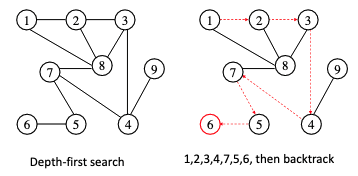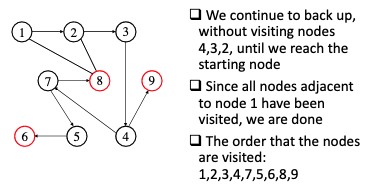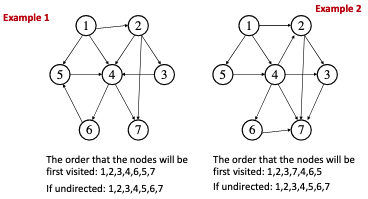Depth-First Search
It allows us to explore nodes and edges of a graph.
The traversal will go as far as possible down a path until a dead end is reached.
In an undirected graph:
- A node is a dead end if all of the nodes adjacent to it have already been visited.
In an directed graph:
- A node is a dead end if it has no outgoing edges and we visited everything else.
Undirected Graph



Directed Graphs

Steps
- Visit the starting node and then proceed to follow links through the graph until a dead end is reached.
- Back up along our path until we find an unvisited adjacent node, and continue in that new direction.
- The process completes when we back up to the starting node and all the nodes adjacent to it have been visited.
- If presented with two choices, we choose the node with numerically and/or alphabetically smaller label (for convenience).
Pseudo-Code
Algorithm 1. DFS(G,n)
Input: G- the graph
n- the current node
1) Visit(n) [Do something to/at node n...]
2) Mark(n)
3) For every edge nm (from n to m) in G do
4) If m is not marked then
5) DFS(G,m)
6) End If
7) End For
Output: Depends on the purpose of the search...
Running Time
DFS is called on each node exactly once, nodes: .
Every edge is examined exactly twice, once from each of its vertices/nodes - edges: .
Therefore, .
If we assume that the work done as we visit each node is the most complex part of the process, the traversal is of order .
Visualisation
Depth-First Search: https://www.cs.usfca.edu/~galles/visualization/DFS.html
Failure
Error: There is another generation process
plugin:obsidian-textgenerator-plugin:56949 TextGenerator.eval plugin:obsidian-textgenerator-plugin:56949:31
Generator.next
plugin:obsidian-textgenerator-plugin:78 eval plugin:obsidian-textgenerator-plugin:78:61
new Promise
plugin:obsidian-textgenerator-plugin:62 __async plugin:obsidian-textgenerator-plugin:62:10
plugin:obsidian-textgenerator-plugin:56935 TextGenerator.generate plugin:obsidian-textgenerator-plugin:56935:12
plugin:obsidian-textgenerator-plugin:58440 AutoSuggest.eval plugin:obsidian-textgenerator-plugin:58440:52
Generator.next
plugin:obsidian-textgenerator-plugin:78 eval plugin:obsidian-textgenerator-plugin:78:61
new Promise